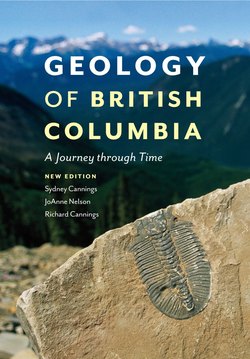Читать книгу Geology of British Columbia - Sydney Cannings - Страница 6
На сайте Литреса книга снята с продажи.
ОглавлениеPreface
MOST PEOPLE ARE drawn to the natural world, at least at first, by its spectacular beauty. We are drawn by the spiritual majesty of mountains, by the perfect elegance of turquoise lakes set in sculpted cirques, by rainbowed waterfalls plunging over rock cliffs, by smooth rock bluffs perched next to an ocean sunset and by rivers winding through dramatic canyons. Whether we realize it or not, we are drawn to rocks and erosion. But many of us are easily distracted by the flashing wings of birds, the colourful beauty of wildflowers or the nobility of large antlers and forget to inquire into the postcard scenery behind them. This scenery is the story of rocks and erosion. But although the stories of the formation of British Columbia, the rise and fall of its mountains and the sculpting of its valleys are fascinating on their own, they are not separate tales from those of the flashing wings, the colourful wildflowers and the big antlers. This book links these stories.
Geology is the foundation of natural history. It tells the story of the minerals that form the soil in which flowers, grass and trees grow. It tells of the movement of continents, the rise and fall of mountain ranges, and the creation of ocean and lake basins, all of which determine the climate of a region, which in turn determines what plants and animals can live there. Continental movements separate and then rejoin biotas, or the flora and fauna of regions, over many millions of years, and glacial ages do the same over tens of thousands of years. Mountain ranges and great valleys determine how animals and plants can or cannot disperse over the landscape. It is impossible to understand ecology and evolution without entering the realms of geology and climatology.
This is an exciting time for geologists and naturalists in British Columbia. The geological history of the province is being rewritten constantly—many discoveries have been made and many new theories have emerged in the decade since this book was first published. And in the realm of biological geography, advances in genetic technologies have shone a bright light on the recent history of animals and plants. Drawing on these latest advances in knowledge, we have completely revised our earlier book to produce this edition. We are extremely fortunate to be joined in this latest effort by our friend JoAnne Nelson of the BC Geological Survey, one of the leaders in big-picture geology in northwestern North America.
In this book we attempt to set the stage for the stories of the natural world around us today. We ask questions such as: How were these rocks formed? Where did they come from? Have there always been mountains here? Where did the Ice Age glaciers come from and what did they do? Where did all the animals and plants go when Canada was covered in ice? How did they get back here? Why does British Columbia have such a diversity of climates and ecosystems? And what are the patterns in those ecosystems?
This is by no means the definitive book on the geology of British Columbia. Rather it is an attempt to bring together a brief, understandable history of the province’s geological features and the history of its living creatures into one cohesive story.
Most outdoor enthusiasts want to learn more about the world they walk, hike, bike, canoe, kayak or climb through. Until recently there were no books in British Columbia that filled that need beyond the level of the generic field guide. This book is designed to both entertain and educate nature lovers of all kinds, and we hope that it will inspire them to want to know more.
The red volcanic rocks of the Rainbow Range in Tweedsmuir Provincial Park, the product of a hot spot in the earth’s mantle, are a testament to the dynamic nature of British Columbia’s geology.
